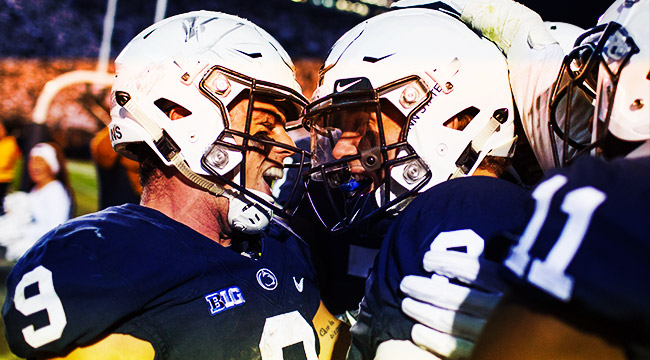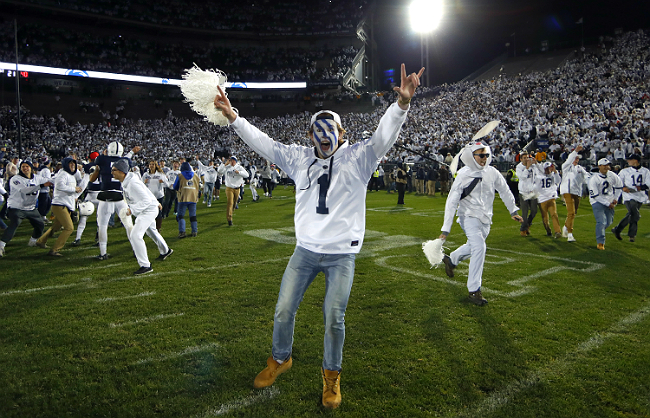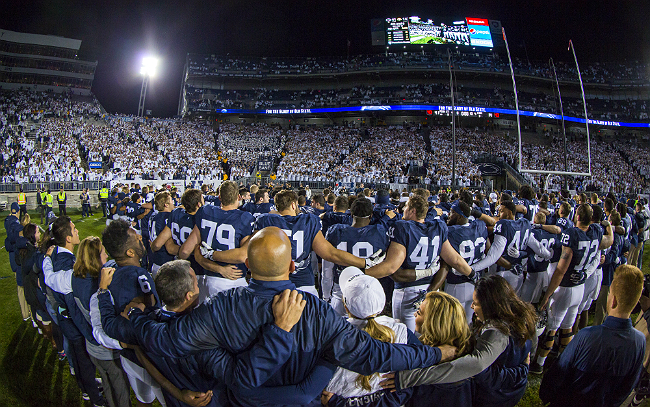
The final score spoke for itself: By any measure, Penn State’s 41-14 win over Iowa last weekend was a thorough, start-to-finish blowout, and the reality on the ground may have been worse than the margin. Offensively, the Nittany Lions racked up more total yards (599) than Penn State had gained in any game since 1995, the majority of it coming via a dominant, 359-yard performance on the ground; defensively, they held the Hawkeyes to 30 yards rushing, two third-down conversions, and a single touchdown prior to garbage time. The loss was Iowa’s worst in two years; the victory was a resounding one all on its own.
In context, though, inside Beaver Stadium, the mounting delirium as the Lions pulled away from an ostensible Big Ten equal felt like a catharsis years in the making. This was, after all, an intensely loyal crowd that has been gradually conditioned for mediocrity: Before this year, the past three seasons all topped out at seven wins, punctuated by a dismal 2-6 conference mark in 2014 and a four-game losing streak to close 2015. By contrast, in the ninth game of the 2016 campaign, it was clear by halftime that this edition was trending emphatically in the opposite direction.
On the same field two weeks earlier, the Nittany Lions had pulled off one of the instant classics of the season — and arguably Penn State’s first really big win in years — rallying from a 21-7 deficit in the fourth quarter to upset then-No. 2 Ohio State in dramatic fashion. Prior to that, the Lions hadn’t beaten a top-five opponent since 1999 (their most recent attempt, at then-No. 4 Michigan in September, saw them on the wrong side of a 49-10 debacle), and suddenly seemed hell-bent on ensuring that it was remembered as a turning point, a catalyst, rather than a passing blip on the national radar. Next came a 62-24 romp over Purdue, Penn State’s highest-scoring effort in a Big Ten game in 11 years. And now Iowa, the toughest remaining test on the November schedule, the last significant hurdle between a program mired in mediocrity and a 10-win regular season, turned out to be no challenge at all.

The Ohio State win marked the end of a five-year drought in the AP poll, where Penn State subsequently debuted at No. 24; the Iowa win vaulted the Lions all the way to No. 12, their highest standing there since 2011. In the latest set of rankings from the playoff selection committee, they come in at No. 9. With a win this weekend at Indiana, they’ll extend their winning streak to six games, Penn State’s longest run in Big Ten play since it ran the table in 1994. Exactly five years after Happy Valley was engulfed by the shroud of the Sandusky scandal, for the first time the gestalt surrounding Penn State football has more to do with its future than with its past.
In a certain sense, of course, the team’s slow emergence from its post-Paterno purgatory is right on schedule: Since the NCAA’s massive 2012 sanctions drop (later scaled back), this is the first season that the roster is back to full strength under the standard 85-scholarship limit, and the first season that none of those scholarships are reserved for players who were on the team when the quake hit in November 2011. At this point, the majority of the locker room is made up of recruits signed by third-year head coach James Franklin.
But many of those young players are beginning to emerge in their own right, especially on offense, where the Lions have made the most obvious strides under new offensive coordinator Joe Moorhead. The unquestioned star of the show is sophomore tailback Saquon Barkley, a perpetual home-run threat who leads the Big Ten in rushing yards, all-purpose yards, and touchdowns, and is well on his way to becoming a bona fide headliner — if not quite a viable Heisman candidate, just yet — well outside of the Rust Belt. Only two other backs in Power Five conferences (Florida State’s Dalvin Cook and Texas’ D’Onta Foreman) have accounted for more yards from scrimmage on the year; no one has been more spectacular over the past month.
The quarterback, sophomore Trace McSorley, has evolved from an obscure, plays-within-the-offense type to a legitimate threat — over course of five-game winning streak McSorley has nine touchdown passes without an interception, and the leads the Big Ten on the season in passes covering at least 30 yards. His top four wide receivers, Chris Godwin, DeAndre Thompkins, Daesean Hamilton, and Saeed Blacknail, have collectively averaged almost 16 yards per catch.
And even more importantly than any individual superlatives, there’s the sense that, on paper, this lineup was arguably built to peak next year. Out of 22 starters against Iowa, only five were seniors — two on offense (both on the line) and three on defense. If the breakthrough arrived ahead of schedule, the expectations for 2017 will be all the more auspicious for it.

In the meantime, it’s hard to resist taking a 10-2 finish for granted on the way to launching prospective bandwagons. The Lions are only seven-point favorites in this weekend’s trip to Indiana — which strikes me as a little generous to the Hoosiers, frankly, although that opinion is offered for entertainment only — but beyond that they’ll be huge favorites in their last two games, against Rutgers and Michigan State, which currently share last place on the Big Ten’s East Division with a combined 0-12 conference record. (The Spartans and Scarlet Knights collide this weekend in the B1G’s unofficial Pillow Fight Bowl.) Even if the B1G East standings end in a three-way tie, Penn State’s odds of winning the division are almost non-existent unless Michigan were to inexplicably lose two of its last three, setting up a straightforward head-to-head tiebreaker between the Nittany Lions and Ohio State. Based on the full Big Ten tiebreaker rules, if all three teams finish 8-1 in conference play Penn State would be ultimately eliminated due to its non-conference loss to Pittsburgh in week two.
Still, with the right break (i.e. Michigan handing Ohio State a second loss, thereby putting the Wolverines in line for a playoff slot and dropping the Buckeyes below Penn State in the B1G pecking order) the Nittany Lions are in good position to crash the conference’s standing invitation to the Rose Bowl; if not, the Orange or Cotton bowls are both possibilities, too, a sentence that would have seemed at least as preposterous at the end of September as certain other poll-driven events of the past few weeks. At the time, Penn State was just an unranked team that already been pantsed by Pitt and Michigan — hardly a candidate for a major bowl game at year’s end, or anytime in the foreseeable future, as the early speculation over Franklin’s job security can attest.
Whatever he did to flip the switch, though, as it roars to the finish line in year three Franklin’s previously lukewarm team is poised to close the season as one of the hottest outfits in the country. And based on how quickly and emphatically the tide has turned, it’s a safe bet that neither he nor the program he’s apparently revived are going anywhere anytime soon.






